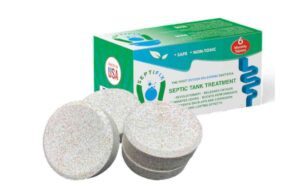Worried about expensive septic system repairs? Let SeptiFix help you avoid costly repairs with our range of septic system maintenance solutions. Our products are safe for use in all types of septic systems and come with a 30-day money-back guarantee. Order now and enjoy fast and secure checkout options! https://adrpress.com/septik-tank-treatment
If you’re in the process of designing or upgrading a septic system, you may be wondering about the benefits and drawbacks of different options. One common type of septic system is the two-tank system, which consists of two separate tanks that work together to treat and dispose of wastewater. In this article, we’ll delve into the specifics of the two-tank system, including how it works, how to maintain it, and its advantages and disadvantages.
How Does a Two-Tank Septic System Work?
A two-tank septic system is designed to separate solid waste from liquid waste, allowing for more efficient treatment and disposal of the wastewater. The first tank, called the septic tank, is where the initial treatment occurs. In this tank, the solid waste settles to the bottom and is broken down by bacteria, while the liquid waste (or effluent) rises to the top.
The effluent then flows into the second tank, which is called the dosing tank or the pump tank. This tank contains a pump or siphon that periodically releases a measured amount of effluent into the drain field or leach field, where it is further treated and eventually absorbed into the soil.
What are the Advantages of a Two-Tank Septic System?
There are several benefits to choosing a two-tank septic system over other types of systems. One advantage is that the separation of solids and liquids allows for more efficient treatment and disposal of the wastewater. By removing solid waste in the septic tank, the effluent is cleaner and less likely to cause problems in the drain field.
Another advantage of a two-tank system is that it can handle a larger volume of wastewater than a single-tank system. This is because the effluent is released into the drain field in smaller, more measured doses, which helps prevent overloading of the system.
Finally, a two-tank system is often more cost-effective than other types of systems, as it can be designed to meet the specific needs of the property and is relatively simple to maintain.
What are the Disadvantages of a Two-Tank Septic System?
While there are many advantages to a two-tank septic system, there are also some drawbacks to consider. One disadvantage is that the system requires more space than a single-tank system, as there are two tanks that need to be installed.
Another potential drawback is that the system may require more frequent pumping than other types of systems. This is because the solid waste in the septic tank can build up more quickly, requiring more frequent removal to prevent clogging and other problems.
How Do You Maintain a Two-Tank Septic System?
Proper maintenance is key to ensuring that a two-tank septic system functions effectively and efficiently. Here are some tips for maintaining your system:
- Have your system inspected and pumped regularly. This will help prevent clogs and other problems, and can help extend the life of your system.
- Avoid putting non-biodegradable items, such as plastics and cigarette butts, down the drain. These items can clog the system and prevent it from working properly.
- Use water efficiently. Avoid doing large loads of laundry or running multiple appliances at the same time, as this can overload the system.
- Avoid using harsh chemicals, such as bleach and drain cleaners, as these can kill the beneficial bacteria in the system that help break down waste.
Conclusion
A two-tank septic system can be a cost-effective and efficient option for treating and disposing of wastewater. By separating solid waste from liquid waste, this type of system can handle a larger volume of wastewater and prevent overloading of the system. However, it does require more space and more frequent maintenance than other types of systems, so it’s important to carefully consider the
specific needs of your property and your budget before choosing a septic system.
If you do opt for a two-tank system, be sure to work with a qualified professional who can help design and install the system, and who can provide guidance on maintenance and repairs as needed. With proper care and attention, a two-tank septic system can provide many years of reliable service, helping to protect your property and the environment.
FAQs
Q: Can a two-tank septic system handle a large family or a lot of guests?
A: Yes, a properly designed and maintained two-tank system can handle a larger volume of wastewater than a single-tank system, making it a good option for families or properties with frequent guests. However, it’s important to avoid overloading the system by using water efficiently and having the system pumped regularly.
Q: How often should a two-tank septic system be pumped?
A: The frequency of pumping will depend on a variety of factors, including the size of the tanks, the volume of wastewater produced, and the number of people using the system. In general, a two-tank septic system should be pumped every 3-5 years to prevent clogs and other problems.
Q: Can I use septic tank additives in a two-tank system?
A: It’s generally not recommended to use septic tank additives, as they can disrupt the natural balance of bacteria in the system and may not provide any real benefits. Instead, focus on using water efficiently and avoiding harsh chemicals that can kill off the beneficial bacteria.
Q: Can a two-tank septic system be installed in any type of soil?
A: No, a two-tank septic system may not be suitable for all types of soil. The drain field or leach field needs to be able to absorb and treat the effluent effectively, which may not be possible in areas with high water tables, shallow soil, or other soil-related issues. A professional installer can assess the soil conditions on your property and help determine if a two-tank system is a good fit.
Q: How much does a two-tank septic system cost?
A: The cost of a two-tank septic system will vary depending on a number of factors, including the size of the property, the volume of wastewater produced, and the soil conditions. In general, a two-tank system is likely to be more affordable than other types of systems, but it’s important to get a quote from a qualified installer to get a more accurate estimate.

Worried about expensive septic system repairs? Let SeptiFix help you avoid costly repairs with our range of septic system maintenance solutions. Our products are safe for use in all types of septic systems and come with a 30-day money-back guarantee. Order now and enjoy fast and secure checkout options! https://adrpress.com/septik-tank-treatment














